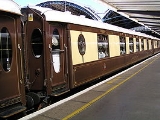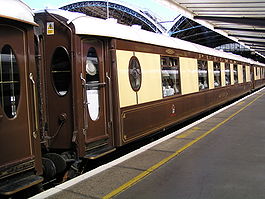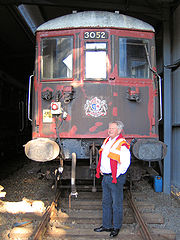
Brighton Belle
Encyclopedia

Southern Railway (Great Britain)
The Southern Railway was a British railway company established in the 1923 Grouping. It linked London with the Channel ports, South West England, South coast resorts and Kent...
from Victoria Station in London
London
London is the capital city of :England and the :United Kingdom, the largest metropolitan area in the United Kingdom, and the largest urban zone in the European Union by most measures. Located on the River Thames, London has been a major settlement for two millennia, its history going back to its...
to Brighton
Brighton
Brighton is the major part of the city of Brighton and Hove in East Sussex, England on the south coast of Great Britain...
, on the Sussex coast. The first electric all-Pullman
Pullman train (UK)
Pullman trains in Great Britain were mainline luxury railway services that operated with first-class coaches and a steward service, provided by the British Pullman Car Company.-Origins:...
service in the world, it ran from 29 June 1934 till 30 April 1972.
History
The London, Brighton and South Coast RailwayLondon, Brighton and South Coast Railway
The London, Brighton and South Coast Railway was a railway company in the United Kingdom from 1846 to 1922. Its territory formed a rough triangle, with London at its apex, practically the whole coastline of Sussex as its base, and a large part of Surrey...
began using Pullman cars in their express trains from 1875, and in December 1881 they introduced the first all-Pullman train in the UK. It was known as the Pullman Limited and ran between London and Brighton via Horsham
Horsham
Horsham is a market town with a population of 55,657 on the upper reaches of the River Arun in the centre of the Weald, West Sussex, in the historic County of Sussex, England. The town is south south-west of London, north-west of Brighton and north-east of the county town of Chichester...
. Subsequently ordinary rolling stock was added to this service. In 1888 a second all-Pullman service was instituted, using carriages lit by electricity and designed by William Stroudley
William Stroudley
William Stroudley was one of Britain's most famous steam locomotive engineers of the nineteenth century, working principally for the London, Brighton and South Coast Railway...
.
The L.B. & S.C.R. was also the origin of the familiar British umber and cream Pullman livery. In 1903 Billinton changed the colour of the ordinary L.B. & S.C.R. coaches to umber brown with white or cream upper panels, and in 1906 this colour scheme was also adopted by the Pullman Car Co., with the name of the car in large gilt letters on the lower panel flanked on each side by a coloured transfer of the Pullman Company's crest.

Three five-car all-Pullman electric multiple units designated 5BEL
British Rail Class 403
The Southern Railway gave the designation 5BEL to the 5-car all-Pullman electric multiple units which worked the prestigious Brighton Belle trains between London Victoria and Brighton. These units survived long enough in British Rail ownership to be allocated TOPS Class 403...
were built for the service and ran throughout the train's life, usually in trains with two sets. The service was scheduled to take 60 minutes for the 51-mile non-stop journey. During the Second World War the service was suspended and the carriages were put into store, but the train was re-instated in 1946.
The 'spare' multiple unit set was used for a Sunday Pullman service from Eastbourne
Eastbourne
Eastbourne is a large town and borough in East Sussex, on the south coast of England between Brighton and Hastings. The town is situated at the eastern end of the chalk South Downs alongside the high cliff at Beachy Head...
, known as the Eastbourne Pullman for much of the 1950s, but this service was discontinued in 1957.
The trains were refurbished in 1955, but by 1972 the stock was old and rode poorly by contemporary standards. Despite public protests the decision was taken not to replace the rolling stock and the service was withdrawn on 30 April 1972. Nearly every carriage was preserved: some, beautifully preserved, are used on the Venice Simplon Orient Express; others became static restaurants, in various states of repair and permanently exposed to the elements. In 1972, one carriage became part of a public house in Winsford, Cheshire - it was removed in 1998 because of the high cost of refurbishment.
Bringing Back The Brighton Belle
The umbrella organisation for heritage transport preservation in the UK - The Transport TrustTransport Trust
The Transport Trust runs the Our Transport Heritage programme which places Red Wheel plaques on especially important sites of transport heritage and, through the programme's website , links together some one thousand transport heritage sites around Britain...
- has been concerned about the general plight of electric train preservation in Britain, the need to raise the profile of the type and a pressing imperative to deal with the issues of financial support and covered accommodation. Under its patronage, a campaign to return the Brighton Belle to mainline service was launched by the 5BEL Trust http://www.brightonbelle.com in 2009. This charitable trust had by early 2009 acquired four cars out of the five needed and had set in place agreements to cover refurbishment of the cars to an exacting standard....in effect, raising the bar for the restoration of electric trains. Restoration of the first driving car, Car 88, began at Pullman restoration specialists Rampart of Derby in February 2009.
The process adopted for restoring each car is complex - the initial bodywork restoration at Ramparts takes about three months. This is followed by three months of engineering work at the Harry Needle Railroad Company at Barrow Hill, Chesterfield, where replacement bogies, brakes and control gear are installed, as well as other detailed safety-related work. The car is then returned to Ramparts for interior restoration and final coachwork.
Once the complete 5BEL set is restored to full operating condition, it will return to mainline operation. Despite the high cost of restoration (close to £2 million) the programme is seen as an investment for future generations and a torch bearer for the preservation of electric trains. Progress with the restoration of the Brighton Belle to mainline use will depend in part on the level of public donations. The Trust intends to have at least part of the train operational in time for the London 2012 Olympics.
Mural
On 23 September 2010, the Mayor of Brighton and Sir William McAlpine jointly unveiled a mural commemorating the Brighton Belle. This is painted into the arches in Trafalgar Street underneath Brighton Station, and runs along the length of the Brighton Toy and Model MuseumBrighton Toy And Model Museum
The Brighton Toy and Model Museum is one of the world's finest toy museums, located in Brighton, East Sussex. Its collection of toys and models extends over four thousand square feet of floorspace, through four of the early Victorian arches supporting the forecourt of Brighton railway station...
.
It depicts the Brighton Belle waiting to depart Brighton Station and features Sir Laurence Olivier, a regular traveller on the train, at one of the carriage windows.
Train Set Completed
During February 2011, Driving Car 88 was displayed on the Brighton seafront to celebrate the acquisition of the Trust's fifth and final car. Following the purchase of historic Pullman car ‘Carina’ by the 5BEL Trust - the carriage formed part of Sir Winston Churchill’s funeral train and carried the principal mourners from London to Bladon on 30 January 1965 - two major rail restoration projects can now be completed. The former Golden Arrow kitchen car has been transferred to the Bluebell RailwayBluebell Railway
The Bluebell Railway is a heritage line running for nine miles along the border between East and West Sussex, England. Steam trains are operated between and , with an intermediate station at .The railway is managed and run largely by volunteers...
to allow them to complete a five-car all-Pullman Golden Arrow rake. In turn, the ex-Brighton Belle Pullman first-class car ‘Doris’ moves to the 5BEL Trust as the final car for their authentic Brighton Belle train set. The Chairman of the 5BEL Trust said that acquiring ‘Doris’ as the Trust's fifth and final car was not only the right move from a heritage standpoint but also it demonstrated the benefits of like-minded organisations working together.

